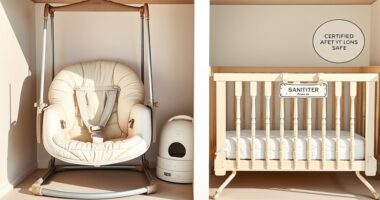Reselling your maternity clothes is a smart, eco-friendly way to save money and reduce waste during pregnancy. By swapping, renting, or listing gently used items online, you extend the life of garments and promote sustainability. These practices help build a circular wardrobe, benefit your wallet, and support environmental efforts. To discover more tips on making the most of resale options and eco-conscious choices, keep exploring how you can maximize these solutions.
Key Takeaways
- Reselling maternity clothes extends their lifecycle, promotes reuse, and supports a circular economy, benefiting both the environment and your wallet.
- Participating in clothing swaps and renting maternity wear offer sustainable, cost-effective alternatives to buying new garments.
- Listing pre-loved maternity items on dedicated resale platforms helps reduce waste and provides financial returns after pregnancy.
- Properly cleaning, packaging, and accurately describing clothes ensures successful reselling and fosters trust among buyers or swap partners.
- Embracing eco-friendly wardrobe management supports sustainability by minimizing clutter and decreasing landfill waste.

Reselling maternity clothes has become an increasingly popular way to save money and reduce waste during pregnancy. As you navigate the changes in your body, you might find yourself needing a variety of outfits without wanting to invest heavily in pieces you’ll only wear for a few months. Luckily, there are several sustainable options to help you manage your wardrobe efficiently. Renting options have gained popularity, allowing you to borrow high-quality maternity wear for a specific period. Instead of purchasing new items you might only wear a handful of times, you can rent stylish clothes for special occasions or everyday use. This approach not only saves you money but also minimizes your environmental footprint by giving garments a longer lifecycle.
Clothing swaps are another excellent way to refresh your maternity wardrobe without spending a dime. Many communities or online groups organize swap events where expecting moms exchange clothes they no longer need. Participating in these swaps means you can try out new styles without purchasing them, and you get the chance to connect with other moms going through similar experiences. It’s a practical, eco-friendly solution that promotes reuse and reduces clutter. When you attend a clothing swap, you’re not just saving money—you’re actively contributing to sustainability by extending the life of maternity garments and avoiding landfill waste.
Participating in clothing swaps helps save money, reduce waste, and connect with other moms during pregnancy.
Beyond renting and swapping, reselling your maternity clothes after pregnancy is a smart move. Once you’re done with them, you can list your gently used items online through dedicated resale platforms or social media groups. This way, other women can benefit from your pre-loved wardrobe, and you get some money back to put toward your next needs. Reselling also encourages a circular economy, where clothes stay in use longer and waste decreases. Additionally, some brands offer resale programs for their maternity apparel, making it easier to participate in sustainable fashion practices.
To get started, evaluate your maternity wardrobe and decide what you no longer need. Clean and package your clothes properly to attract buyers or swap partners. When participating in rentals or swaps, be clear about the condition of your clothes and set expectations upfront. This transparency helps foster trust and ensures everyone has a positive experience.
Frequently Asked Questions
How Do I Determine the Resale Value of Maternity Clothes?
To determine the resale value of maternity clothes, start by researching current market demand for similar items online. Use pricing strategies like checking listings on resale platforms and noting what sellers are asking. Consider the condition, brand, and style of your clothes, adjusting the price accordingly. Keep in mind that popular, gently used pieces tend to fetch higher prices, so set a competitive yet fair price based on demand.
What Are the Best Platforms for Selling Maternity Apparel?
You should explore online marketplaces like eBay and Poshmark, which offer broad audiences and easy listing options. Consignment shops are also great, especially if you prefer in-person sales or local transactions. Both platforms help you reach different buyers, ensuring your maternity apparel sells quickly. Use clear photos and detailed descriptions to attract more customers, and consider combining online and consignment shop sales to maximize your earnings.
How Can I Ensure the Quality of Pre-Owned Maternity Clothing?
To guarantee the quality of pre-owned maternity clothing, you should start with thorough fabric inspection to check for stains, tears, or wear. Confirm sizing accuracy by comparing measurements to standard size charts and inspecting tags. Wash or sanitize items before selling to ensure cleanliness. Additionally, examine zippers, buttons, and seams for durability. This careful approach guarantees your customers receive high-quality, safe, and comfortable maternity wear.
Are There Specific Cleaning Tips Before Reselling Maternity Wear?
Imagine fresh, clean fabric with a soft scent—start by following laundry guidelines specific to maternity wear. Use gentle detergents and cold water to preserve elasticity. For stain removal, act quickly with a stain remover or mild soap, gently dabbing the area—avoid scrubbing. Guarantee thorough rinsing and air dry or lay flat to maintain shape. These steps help your pre-owned maternity clothes look and feel their best for resale.
What Legal Considerations Should I Be Aware of When Reselling?
When reselling maternity clothes, you should review contract laws to make certain your sales agreements are clear and legally binding. It’s also wise to include liability waivers to protect yourself from potential returns or damages. Always disclose any flaws or wear, and familiarize yourself with local consumer protection laws. Keeping detailed records of transactions can help you stay compliant and avoid legal issues as you grow your resale business.
Conclusion
By choosing to resell your maternity clothes, you’re planting seeds for a greener future, nurturing sustainability with each swap. Think of your maternity wardrobe as a blooming garden—each piece shared or reused helps it flourish rather than fade away. Embrace this cycle, and you’ll find that your journey through pregnancy becomes not just about growth, but about giving back to the planet. Together, we can turn the cycle of maternity clothes into a beautiful, sustainable garden.









